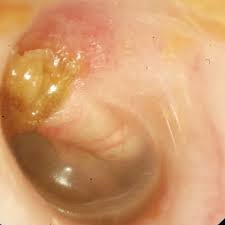Mastoidectomy is a surgical procedure performed to remove infected mastoid air cells, typically due to chronic otitis media or cholesteatoma. While the surgery effectively manages infections, complications such as mastoidectomy cavity infections can occur, leading to persistent discomfort, discharge, and hearing complications.

Causes of Mastoidectomy Cavity Infections
1. Bacterial and Fungal Infections
- Common Pathogens: Pseudomonas aeruginosa, Staphylococcus aureus, Proteus species, and fungal agents like Candida and Aspergillus.
- Risk Factors: Poor hygiene, incomplete removal of infected tissue, and excessive moisture in the cavity.
2. Residual or Recurrent Cholesteatoma
- Incomplete excision of a cholesteatoma can lead to recurring infections and further complications.
- Signs include foul-smelling otorrhea (ear discharge) and cavity breakdown.
3. Poor Postoperative Care
- Lack of regular cavity cleaning and improper antibiotic use increases infection risks.
- Patients with diabetes, immunodeficiency, or previous middle ear infections are at greater risk.
4. Retained Surgical Packing or Debris
- Residual packing materials or necrotic tissue can become a breeding ground for bacteria and fungi.
Symptoms of Mastoidectomy Cavity Infections
- Persistent ear discharge (otorrhea)
- Ear pain or discomfort
- Foul odor from the ear
- Swelling or redness behind the ear
- Hearing loss
- Fever (in severe cases)
Diagnosis
1. Clinical Examination
- Otoscopic and microscopic evaluation to assess the cavity.
2. Microbiological Testing
- Culture and sensitivity tests for identifying bacterial or fungal agents.
3. Imaging Studies
- CT scan to evaluate bone erosion or residual disease.
Treatment Options
1. Antibiotic and Antifungal Therapy
- Topical antibiotics (e.g., ciprofloxacin ear drops) for mild infections.
- Oral/IV antibiotics for more severe cases.
- Antifungal drops for fungal infections.
2. Frequent Ear Cleaning and Suctioning
- Performed by an otolaryngologist (ENT specialist) to remove infected debris.
3. Surgical Revision
- Required in chronic or non-responsive infections.
- Types of surgical interventions:
- Canal wall up mastoidectomy (preserving the bony canal)
- Canal wall down mastoidectomy (leaving an open cavity for drainage)
Prevention Strategies
- Regular follow-ups with an ENT specialist.
- Meticulous ear hygiene to prevent bacterial growth.
- Proper wound care after surgery.
- Avoid water exposure in the ear canal post-surgery.
- Timely removal of packing material as advised by the surgeon.
Mastoidectomy cavity infections can significantly impact a patient’s recovery and quality of life. Early diagnosis, targeted treatment, and preventive measures are crucial for managing complications. Patients should maintain regular postoperative care and seek medical attention if symptoms persist. By adopting a proactive approach, we can ensure optimal ear health and prevent chronic complications.

